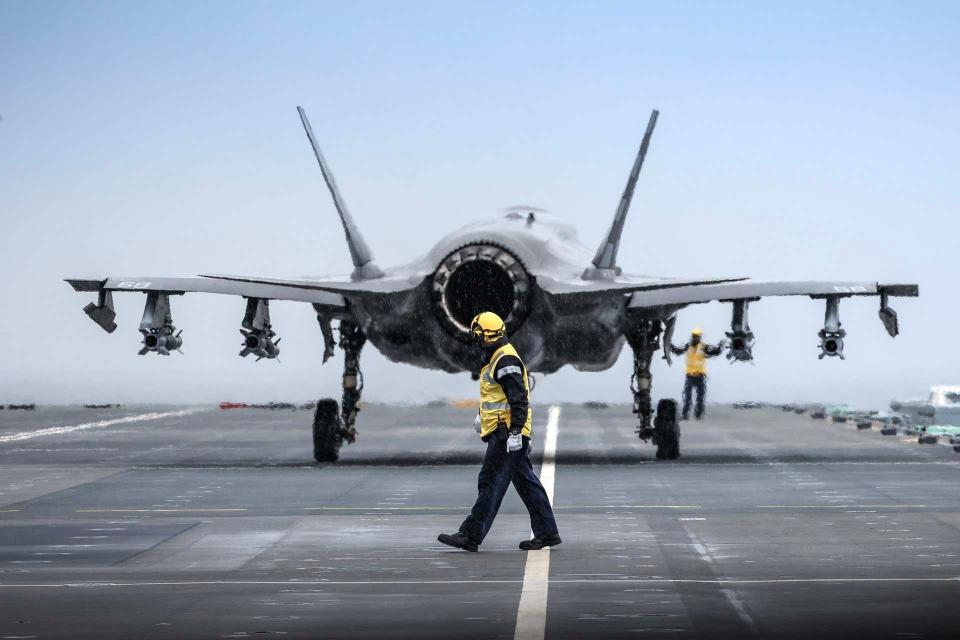The British navy's newest aircraft carrier teamed up with US pilots to launch F-35 jets in 'beast mode' for the first time
The UK's newest aircraft carrier conducted a series of tests off the east coast of the US in October.
The tests saw several firsts for the carrier, including the first launch of a fully loaded F-35B.
The US and UK have worked together closely to expand the capabilities of the UK's new carriers.
At the end of October, the Royal Navy took its naval-aviation capabilities to the next level by launching a fully loaded F-35B from the aircraft carrier HMS Prince of Wales for the first time.
The F-35B took off in "beast mode," a configuration in which its internal weapons bays and external pylons are all fully loaded with missiles or bombs. "Beast mode" sacrifices an F-35's stealth for increased firepower, as externally mounted munitions increase the aircraft's radar signature.
During the test, a specially modified F-35B carried 22,000 pounds of inert bombs, its maximum capacity, the Royal Navy said.

"It was impressive, launching the jet, all bombed up from the back of the flight deck," said Warrant Officer 1 John Etherington, the captain of the flight deck aboard HMS Prince of Wales. "It's exciting to see us pushing the boundaries of UK naval aviation."
The F-35B is the short-takeoff-and-vertical-landing variant of the jet and the most mechanically complex of the F-35 family. The -B variant is designed to operate from shorter runways, such as those aboard US amphibious ships and the UK's aircraft carriers.
While F-35Bs have been taking off from the 350-foot mark on HMS Prince of Wales' flight deck, a fully laden F-35B, depending on the conditions, may have to take off from as far back as the 850-foot mark, almost at the end of the carrier's 920-foot flight deck.
A series of firsts

This wasn't the only aviation breakthrough that took place aboard the British aircraft carrier during Westlant 2023, its current deployment off the East Coast of the US.
In September, as the carrier left the UK, it participated in a first-of-its-kind naval-drone test to demonstrate the ability of unmanned aircraft to carry cargo to the ship, freeing its helicopters of that mission.
The F-35Bs, flown from a US base by US Marine Corps pilots, joined the carrier in mid-October, ahead of the "beast mode" tests. Those tests were also the first time an aircraft launched by HMS Prince of Wales had dropped bombs, albeit inert ones.
Perhaps the most important tests involved shipborne rolling vertical landings. SRVL is a recent British innovation. The first one was performed in 2018 aboard HMS Queen Elizabeth, Prince of Wales' sister ship and the lead ship of the class.

During an SRVL, the jet uses both the vertical thrust from its engine and the lift from its wings. The benefits are that an SRVL doesn't require arresting gear, as carrier landings normally do, and it reduces wear on a jet's lift engines.
More importantly, an SRVL allows a jet to land with more weight than it can carry during a vertical landing, meaning F-35B pilots shouldn't have to ditch excess fuel tanks and expensive munitions to land safely on the carrier.
The Prince of Wales and the Queen Elizabeth have no arresting gear, so jets can only land vertically or by performing an SRVL, making mastery of the technique crucial for the ship and its crew. During the tests, the carrier conducted a total of 60 rolling landings, including 10 at night.
The F-35Bs were modified to carry testing sensors and were flown by US Marine pilots from a test-and-evaluation squadron assigned to Naval Air Station Patuxent River in Maryland. A 200-strong team from Pax River's F-35 Integrated Test Force also deployed on board HMS Prince of Wales to support the tests.

Westlant 2023 is only the latest round of trials for the jet and the carriers. This deployment focused on expanding the capabilities of both of Britain's new carriers, especially their ability to launch and recover F-35s faster, in worse weather, and at day or night.
US and British experts will now analyze the data gathered during the tests, "but the ship's command team are confident the trials have 'expanded the envelope' of F-35 operations," the Royal Navy said.
"The last four weeks at sea have been the busiest HMS Prince of Wales has ever seen," the ship's commanding officer, Capt. Richard Hewitt, said this week. "The test points achieved will not only improve UK F-35B operations, but those of our F-35B program partners and allies as well."
Prince in the North Atlantic

HMS Prince of Wales entered service in 2019, two years after HMS Queen Elizabeth. They can each carry up to 36 F-35Bs and a number of Merlin helicopters.
The two conventionally powered vessels each displace 65,000 tons and are the biggest warships ever built by the Royal Navy. By comparison, the US Navy's Nimitz-class and newer Gerald R. Ford-class nuclear-powered carriers each displace 100,000 tons.
HMS Prince of Wales was meant to sail to the US in late summer 2022 but was sidelined by an "extremely unusual fault" in one of its propeller shafts, which forced it to enter a dry dock for several months of repairs. Prince of Wales has now followed HMS Queen Elizabeth to the US, and it's a welcome arrival.
"It's a pleasure to see the continued progress in operating capability — there has been undeniable growth," said US Marine Corps Lt. Col. Mike Lippert, a test pilot who has participated in F-35B trials aboard both British carriers.
Constantine Atlamazoglou works on transatlantic and European security. He holds a master's degree in security studies and European affairs from the Fletcher School of Law and Diplomacy. You can contact him on LinkedIn and follow him on X/Twitter.
Read the original article on Business Insider

 Yahoo News
Yahoo News 
